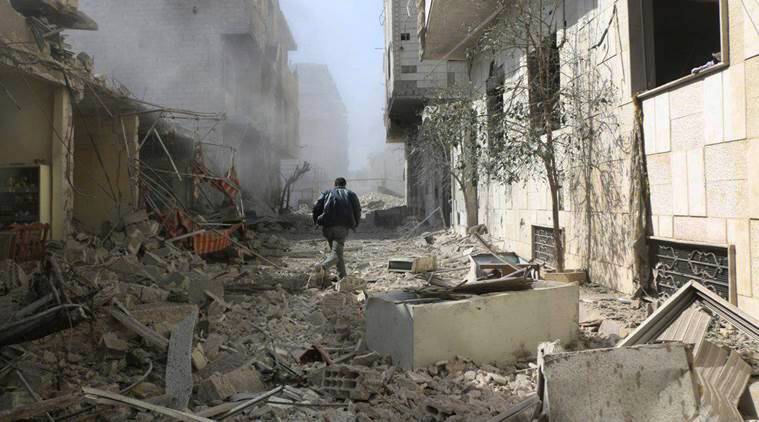In late April 2022, a Syrian protester leaked a video of the Tadamon massacre. Hundreds of Syrian families watched the clip, hoping to learn what happened to their missing sons.
The Siam family also saw this. His son, Wasim Siam, left his home in Damascus on the morning of April 14, 2013. He was ordered by the government to deliver flour to a government bakery in the city’s southern Tadamon neighborhood. The 34-year-old never returned from what should have been a routine task.
For many years, Siam, now living in Germany, believed that Wasim was arrested at a checkpoint and taken to a government prison. Yet the leaked video finally exposed them to the gruesome details of his disappearance.
The clip shows a man blindfolded in a white T-shirt and jeans being led down an empty street into a pit full of corpses.
“My father recognized him first” [in the video]Wasim’s sister Tasneem Siam says that her father recognized his son by his tricks. “He seemed so different, they had already beaten him, maybe even afraid.”

They killed Wasim by jumping into the pit.
Tasneem Siam asks, “This is real, how can I process the fact that the man being killed in the video is my brother.”
playing with victims
The leaked video was recorded on April 16, 2013, just days after Wasim’s disappearance. It shows two uniformed men systematically killing 41 people. Each time, one of the two finds a blindfolded man from a white delivery van, leading the man into a large pit that already contains several corpses and car tires. They are pushed in and shot. Then, the bodies are immersed in fuel and set on fire.
The Syrian War has been going on for 11 years now, during which countless atrocities have been committed by all parties involved in the fighting. The Tadamon massacre video, which was recorded in government-controlled Damascus at the time, however, shows that the brutality stands out for the planned nature of the brutality.
It is clear from the video that both the executioners are enjoying their ‘work’. They murder civilians in broad daylight in a quiet, routine manner. They play a twisted game with their victims, falsely telling them that the street they are passing is being targeted by snipers, so blindfolded victims run away and fall into the pit. Before they know what has happened, they are shot.
Killers who felt untouchable documented their crimes by filming high-definition footage. Sometimes they wave at the camera and crack jokes. Why did they register their crimes? Did they want to make “war trophies”? Or show your superiors that they were doing as they were ordered? Whatever the reason, it is highly unlikely that they thought the video would be seen by the public.
identity of the killers
Ugur Umit Ungor, professor of Holocaust and Genocide Studies at the University of Amsterdam, was among the first to receive a copy of the clip in 2019. Working with their colleague Ansar Shahhoud, the two were able to identify the two killers in the video. : Najib al-Halabi, now dead, was part of a militia loyal to Syrian President Bashar Assad; The other man seen wearing a fishing cap is Amjad Yusuf. He is an officer in Assad’s secret service.
“The last two years were hellish for us,” Ungor told DW. “Imagine you know about a horrific massacre, need to watch this video over and over, but can’t tell anyone else about it.”
Analyzing videos to identify the killers was nothing like ordinary academic research. They set out to do what few have managed to achieve so far: provide convincing evidence that the Syrian state is directly responsible for some of the worst atrocities committed in the war.
‘I killed many people’
Ungor and his Syrian colleague Shahhoud used unconventional research methods. Shahhoud adopted a fake online identity to betray the Syrian regime and learn more about the men behind the massacre.
Shahhoud pretended to be a young Alawite woman from Homs by the name of “Anna Sh”, who supported Alawite President Assad. The Guardian newspaper was the first to cover how, over the course of two years, Shahhoud was able to speak to hundreds of Assad employees and win their trust. One day, she stumbles upon Amjad’s online profile. Shahhoud befriended the man in the form of Anna. Sometimes, they chatted on the phone, with Ungor secretly listening.

Amjad Yusuf tells him that he feels lonely and stressed. Shahhoud’s fictitious character raised his ears. After several months, he told her: “I killed many people.” Both the academics had finally achieved their goal.
The two passed the recorded conversations to Dutch and German prosecutors, and described their findings in New Lines magazine.
“We couldn’t look back and say: We are academics, we do research, blow this revelation on social media and don’t get involved,” Ungor says. “We had to take responsibility.”
Evidence of war crimes
The six-minute leaked video offers convincing evidence of crimes as they were committed by identifiable perpetrators and victims. It also suggests that the killings were a pre-arbitration homicide. A mass grave was prepared, with both killers working regularly and attempting to hide the identities of their victims.
Alexander Schwarz, an expert in international criminal law with Amnesty International, said the video shows the killings follow a systematic pattern. “A systematic attack on civilians, as seen in this video, is a criterion for a crime against humanity.”
Still, it’s not clear whether these revelations will lead to a test. Syrian officer Anwar Raslan was sentenced to life imprisonment by a German court in Koblenz in January, however, indicating that the surviving executioner in the video may be on trial.
Additionally, the video is of great political importance, according to Fritz Streiff, who provides legal advice to Mnemonic, an organization documenting human rights abuses. He argued that its shocking nature suggests that nations should not normalize relations with the Assad regime.
“It’s not just about Amjad Yusuf,” Ungor says. “It’s also about the system that makes people like him.”
Close to families?
Schwarz and Streiff work with people whose relatives have disappeared in Syria. Shedding light on the disappearance of loved ones, as the Anwar Raslan case did, can set off some families.
Tasneem, sister of the slain Wasim, does not have much hope.
“I know you need to stay positive in life, but we’ve lost all hope,” she says. “We are alive only because we want to be.
“I want people to understand why some of us need months or years to settle down [in Germany],” she says. “Some people never settled down, because they endured things in Syria that were so horrifying that no normal person could ever imagine them.”



